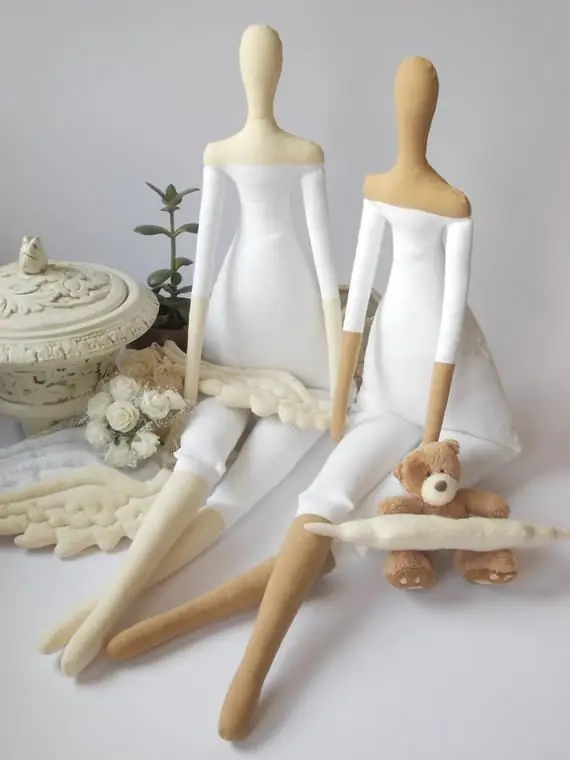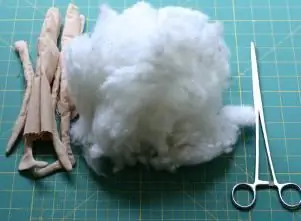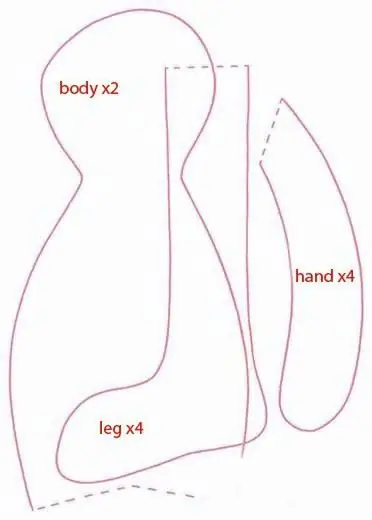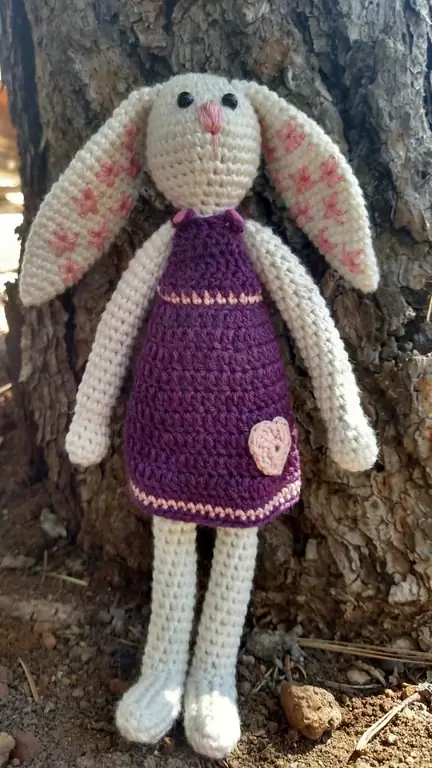
Inhaltsverzeichnis:
- Autor Sierra Becker [email protected].
- Public 2024-02-26 04:44.
- Zuletzt bearbeitet 2025-01-22 22:11.
Der norwegische Designer Toni Finnanger entwarf einst ein Spielzeug, das seit mehr als einem Jahrzehnt Herzen erobert und die goldenen Hände von Handwerkerinnen hält. Tilda ist der Inbegriff von Komfort und Gemütlichkeit. Sie ist mit enormer positiver Energie ausgestattet und kann jeden in die Welt der Kindheit zurückbringen. Aber der Tilde-Stil ist nicht nur auf Puppen beschränkt. Dies ist eine ganze sanfte und freundliche Welt mit sowohl einfachen als auch virtuosen Spieltechniken.

Ein kleiner Teil dieser magischen Welt ist die Tulpentilde. Sie können es zum Beispiel Ihrem geliebten Freund zu Ehren eines Feiertags schenken.
Was ist eine Tilde-Tulpe
Wenn wir das Wort "Tilde" sagen, meinen wir damit die ganze Welt. Es umfasst nicht nur Puppen mit aufwändiger Kleidung und Accessoires, sondern auch eine große Auswahl an primitivem Spielzeug. Eines dieser primitiven Souvenirspielzeuge sind Tilde-Tulpen, eine Meisterklasse für die Herstellung, die in diesem Artikel besprochen wird. Es waren diese primitiven Blumen, die es geschafft haben, die Herzen der Menschen auf der ganzen Welt zu erobern und mit ihren zu schlagenSchlichtheit und Schönheit zugleich.
Aus welchen Stoffen werden Tildeblumen (Tulpen) am meisten bevorzugt
Fleece-Tulpen sind am angenehmsten und kuscheligsten, obwohl Sie eigentlich jeden Stoff verwenden können. Natürlich sollten für Stängel und Blätter Grüntöne gewählt werden. Tulpenstiele aus kariertem Stoff oder gepunktetem Stoff sehen sehr interessant aus. Für Knospen sind Satin, Satin oder andere glänzende Materialien am spektakulärsten. Das Wichtigste dabei ist, keine Strickwaren und zu dichte Stoffe zu wählen.

Vom Farbschema her sehen die Farben Weiß, Gelb und Rosa am vorteilhaftesten aus. Sowie eine Kombination verschiedener Optionen in einer Knospe. Alle Stoffe sollten vor Gebrauch in warmem Wasser gewaschen und gebügelt werden.
Tilda Tulpen: MK. Werkzeuge und Materialien
Zuerst brauchst du Stoff für die Knospen, Blätter und Stängel. Auch eine Nadel und Faden in allen notwendigen Farben. Zusätzlich zu all dem oben Genannten benötigen Sie eine Schere, einen Füllstab und Füllmaterial. Als letzteres können Sie Sintepukh oder Hollow Fiber verwenden.

Manchmal ist Draht praktisch. Mit seiner Hilfe können Sie den Stiel der Blume nicht nur stärken, sondern ihm auch eine Form geben. Sie benötigen auch eine Nähmaschine, aber wenn Sie keine haben, sollten Sie sich nicht aufregen. Solche Blumen lassen sich leicht von Hand mit einem "Vorwärtsnadelstich" nähen. Und natürlich geht es auch ohne Muster nicht.
Tulpenmuster
Tilda-artige Tulpen, deren Muster in diesem Artikel vorgestellt wird, sind überhaupt nicht schwer zu nähen. Und die Muster sind recht einfach. Es stimmt, es ist erwähnenswert, dass die Knospen zwei Arten von Mustern haben. Vielmehr ist es nicht die Form selbst, die sich unterscheidet, sondern die Anzahl der Teile, die zur Herstellung der Knospen verwendet werden. Es können zwei oder vier sein. Genau das ist der Unterschied.

Tilde-Tulpen, deren Meisterklasse später besprochen wird, impliziert die folgenden Größen. Das Detail für die Knospe ist neun Zentimeter hoch und an der breitesten Stelle fünfeinhalb Zentimeter. Das Tulpenblatt ist an seinem größten Abschnitt ebenfalls fünfeinhalb Zentimeter breit und sechzehneinhalb Zentimeter lang, das Detail für den Stiel ist ein Rechteck mit Seiten von zwanzigeinhalb Zentimetern. Natürlich die Nahtzugaben nicht vergessen.
Stamm erstellen
Jede Tilde-Tulpe hat einen Stiel. Beginnen wir mit ihm. Nehmen wir ein rechteckiges Stück, das für den Stiel der Blume entworfen wurde. F alten Sie es in der Mitte und nähen Sie die lange Seite und eine der kurzen. Die zweite Hose bleibt zum Füllen ungestickt. Nach dem Nähen sollten alle Zulagen beschnitten und auch eine Ecke abgeschnitten und der zukünftige Stiel verdreht werden. Schneiden Sie den Stoff nicht nahe an der Naht. Beim Füllen kann sich der Stiel lösen. Jetzt bleibt es, unseren Teil zu füllen. Sie können den Stiel einfach mit Füllmaterial füllen oder ihn mit Draht verstärken. Dann kann Ihre Tulpentilde gebogen und in dieser Position fixiert werden.
TunBlätter
Es ist unmöglich, sich eine Blume ohne Blätter vorzustellen. Auch Tilde-Tulpen, deren Fotos Sie in diesem Artikel sehen können, enth alten alle mindestens ein Blatt. F alten Sie die beiden Papierbögen einander zugewandt, heften oder heften Sie sie fest und nähen Sie sie zusammen, wobei Sie die Unterseite offen lassen, um sie umzukrempeln. Ideal wäre es, wenn Sie die Möglichkeit hätten, die Zugabe mit einer Zickzackschere zuzuschneiden. Aber wenn Sie keine solche Schere haben, können Sie an gekrümmten oder besonders hervorstehenden Stellen einfach mit einer gewöhnlichen Schere Kerben machen. Dies ist notwendig, damit das Blatt beim Umstülpen an allen Stellen eben ist und keine unnötigen F alten entstehen. Bügeln Sie das fertig gewendete Blatt und legen Sie eine Linie entlang der Kante. Dies wird Ihrem Prospekt etwas Glanz verleihen.
Knospen erstellen
Der wichtigste und schönste Teil der Tilde-Tulpe ist ihre Knospe. Wie oben erwähnt, kann es aus zwei oder vier Teilen bestehen. Wenn Sie noch nichts Besonderes genäht haben, entscheiden Sie sich für eine Knospe, die aus zwei Teilen besteht. Machen Sie es einfacher, und es wird viel genauer ausfallen. Das Schneideprinzip ist das gleiche wie bei den Blättern. Zwei Teile zusammennähen, auf links drehen und gut ausstopfen. Anders als bei Blättern müssen Sie den Rand natürlich nicht abnähen. Wenn die Knospe voll ist, müssen Sie sie im Bereich der Unterkante festziehen und mit einer verdeckten Naht an den Stiel nähen.

Es gibt noch eine weitere interessante Version der Knospe. Sein Muster hat die Form eines Rechtecks, und zuerst wird eine Hälfte einer Schaumstoffkugel der gewünschten Größe hineingesteckt und dannFüllmaterial ist bereits vorhanden. Das Rechteck wird entlang der langen Seite in der Mitte gef altet und an der Seite genäht. Dann wird es unten zusammengezogen und der obere Rand einfach hochgesteckt. Im Inneren legen wir eine Hälfte der Kugel mit der konvexen Seite zum Stiel. Es wird helfen, die Form der Knospe zu erh alten. Legen Sie den Füller darauf. Nun muss der Button geschlossen werden. Verbinden Sie dazu seine gegenüberliegenden Seiten an den Mittelpunkten miteinander. In die Mitte dieses Gelenks wird normalerweise eine Perle eingenäht.
Nun, die Tilde-Tulpe ist fertig. Es bleibt uns nur, irgendwo in der Mitte des Stiels ein Blatt zu nähen und über das Design nachzudenken. Es kann nur ein schöner weicher Blumenstrauß sein, der mit einem geeigneten Band gebunden ist. Oder Sie "pflanzen" ein paar Blumen in einen provisorischen Topf oder eine Kiste.

Richtig, dafür müssen Sie Draht in die Stiele einführen. Und mit Hilfe solcher Tulpen erh alten Sie eine schöne und gemütliche Komposition. Zum Beispiel ein weicher Kranz an der Tür. Denken Sie daran, dass die Schönheit von Tulpen weitgehend davon abhängt, aus welchem Material Sie sie herstellen. Und obwohl dies als primitives Spielzeug gilt, verbietet niemand, die gesamte Komposition mit zusätzlichen dekorativen Elementen zu dekorieren. Nähen Sie zum Beispiel einige Perlen an die Knospe oder kleben Sie einen künstlichen Schmetterling an den Strauß. Deshalb ist er ein kreativer Prozess, zum eigenen Vergnügen zu experimentieren.
Empfohlen:
Tilda-Puppe: Kleidungsmuster, interessante Ideen mit Fotos und Nähtipps

So erstellen Sie Kleidungsmuster für Tilda-Puppen: drei Möglichkeiten. Klassisches Muster mit einem Regal und einer Rückseite. Eingenähter Ärmel. Umlegekragen. Maße und Muster zum Nähen einer Puppe mit einer Höhe von 35 Zentimetern und eine detaillierte Erklärung, wie man ein Grundmuster für sie baut. Ein Beispiel für den Aufbau einer Jacke nach dem Grundmuster. Wie man Hosen näht - das Prinzip, ein lebensgroßes Kleidungsmuster für Tilda zu konstruieren
Tilda do it yourself - eine ausführliche Meisterklasse

Do-it-yourself Tilda ist einfach und sehr interessant. Geboren aus Ihrer Inspiration und Vorstellungskraft, wird es einzigartig sein. Das findest du nicht im Shop. Du wirst sie verehren, weil du ein Stück deiner Seele in sie gesteckt hast. Die Puppe wird Ihre Küche, Ihr Schlafzimmer und jede Ecke des Hauses schmücken. Wenn du ihr Flügel machst, wird sie dein Schutzengel. Willst du schon einen haben? Dann kommen Sie zur Sache
Tilda-Stil: Muster von Hasen und eine detaillierte Meisterklasse

Hasenmuster - so nähst du das schönste Tilda-Spielzeug. In diesem Artikel findest du alle nützlichen Informationen, Schnittmuster und Nähtipps
Wie verdient man Geld mit dem, was man liebt? Gehäkelte Tilda-Puppe. Planen

Jedes Spielzeug trägt natürlich eine emotionale Ladung. Ihre Macht hängt davon ab, wie und von wem sie gemacht wurde. Handgemachtes Spielzeug erweckt mehr Selbstvertrauen. Sie spüren die Seele des Meisters, sie vermitteln die Wärme der Hände der Person, die sie gemacht hat. Sie werden gerne für kleine Kinder ausgewählt. Erwachsene kaufen Puppen in ihren Sammlungen, aber meistens werden sie zum ersten Spielzeug von Neugeborenen. Dies erklärt die Beliebtheit von handgemachtem Spielzeug
Tilda-Ballerina: Beschreibung, benötigte Materialien, Aufbaureihenfolge

Ballerinas haben ihre Umgebung schon immer mit ihrer Anmut und überirdischen Leichtigkeit begeistert. Vielleicht war das Spielzeug in luftigen Tutu-Röcken deshalb schon immer eines der beliebtesten unter den Mädchen, gleich nach den brillanten Prinzessinnen. Lassen Sie uns herausfinden, wie man eine heute beliebte Tilda-Ballerina-Puppe mit eigenen Händen herstellt, und überlegen Sie auch, wie sie sich von anderen Textilspielzeugen dieser Art unterscheidet
